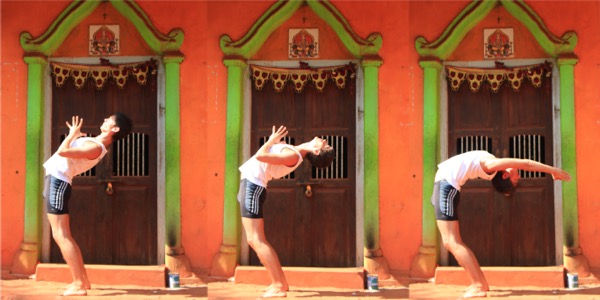A couple of days ago I was helping a student that was attempting to bind in Marichyasana D (don’t we all love this asana). It was during Mysore Class which gave me the opportunity to really spend time and give my full attention to the student – one of the main reasons why I love this kind of class.

I sat down next to her and talked her through a routine of steps, addressing each body part involved in it – ankle, knee, hips, spine, shoulders. I usually choose this approach instead of simply adjusting the student, unless it’s obvious the person could do it or I really know the person from following their daily practice for a while.
The advantage of giving verbal instructions is that the student has to do all the actions by herself instead of being pushed and pulled into the asana with an adjustment. The adjustment might get the student quicker into the pose, but if I don’t know the student or am not sure how she feels in her knee and ankles, I prefer the verbal approach first.
So back to the story: We attempted to go deeper five times, and 5 times she stopped at the same moment, started shaking her head as to say “no way” and told me she cannot do it. My reply was always asking her: Where do you feel an obstacle? Is there any pain? As there was no pain I kept suggesting to try again.
Then she suddenly went all the way and did the full asana, binding her hands, breathing. Even I was perplex for a moment. What had happened? I don’t know. She didn’t know.
Here are some take aways:
Don’t just push and adjust your students as the only means to experience an asana
Talk to them and let them do the work. The work and exploration is where learning can take place.If they cannot explore and self-inquire and feel what’s going on in their own bodies, how can they grow awareness in their practice?
Ask questions instead of just giving them the answers. Then they have to reflect what is stopping them. Plus you as the teacher might actually learn something about what they are experiencing – and it might be completely different to what you feel in a particular asana.
The mind is a suggestion engine
The mind produces thoughts – and it produces the whole day. We won’t stop the stream of thoughts, we might just detach from it, and we surely shouldn’t take every thought as fact, rather as a suggestion.
When attempting a challenging asana, thoughts might come up like
“I want to stop”,
“This feels too uncomfortable”,
“I can definitely do the full asana today”,
“My hip is not open enough”,
“My hip is very open and can do it”.
Any of these thoughts might be helpful or dangerous, motivating or limiting. It’s our job as a practitioner to notice and explore what is behind every thought, check it for accuracy (as we do with any suggestion, right?) and how it’s related to what’s happening in this very moment.
As a teacher it can be helpful to inquire the thoughts of the student, point out obvious false claims of the mind (you know this person that say “I cannot do it” and then does it a second later?) and urge the student to actually feel what is happening in the moment instead of following a (maybe habitual) thought (see next point)
Show persistence with your students
To get over limits and develop our potential, we need to get over the mind barrier. I forgot the exact statistics, but about 90 percent of the thoughts that you thought yesterday, you will think again today and tomorrow. If we have habit thoughts such as I am not strong, I am stiff, I cannot do that, you will most likely have them also in your Yoga practice. What helps is getting aware of those thoughts, when they appear, switching them around into a positive thought and not letting yourself be held back by these thoughts.
If you are a teacher, be persistent and keep inquiring and challenge the student to test whether their thoughts are helpful in the present moment.
Use discomfort as a sign, not a reason to quit
Discomfort can be a sign to back up – especially if the discomfort involves pain. Yet it can also mean
“deepen your breath”,
“find another way”,
“adjust a certain body part”,
“open another body part more”
There are many ways to deal with discomfort, and running away is not a good one.
Is there a chance for injury – modify to be safe. Is the discomfort just a thought – let the thought go and get back into your body. Is there a way to adjust myself – do it. Discomfort does not mean to stop what you are doing. It’s a sign for further exploring the situation and finding different angles, modifications, and of course acknowledging the actual limits of your body and mind in that moment. But any limit is temporary – never take it as a final.
As always, those ideas require you as the teacher to practice what you teach and to be genuinely curious in students practice.
